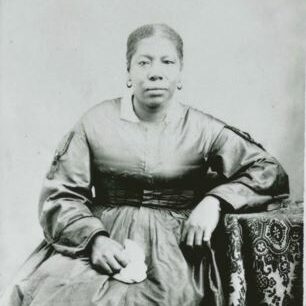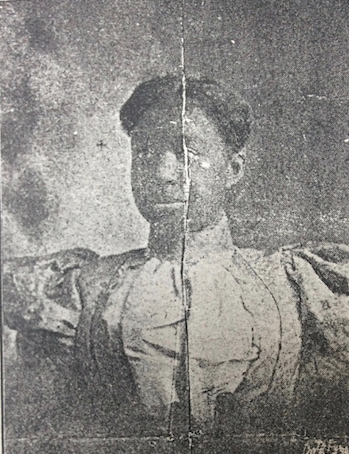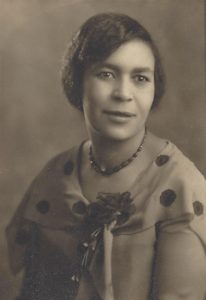Date: July 7, 2022 (Season 4, Episode 15: 63 min. & 52 sec. long). Click Here for the BuzzSprout version of this Speak Your Piece episode. The above photo is of Ava Isom and Dr. Jackie Thompson, as they pose for photos at the unveiling ceremony for the mural featuring the four Black women who lived and worked in Utah (June 27, 2022). Isom (13) is dressed as Elnora Dudley (one of the four women on the mural) who was crowned as queen at the 1898 Emancipation Day Celebration. Photo courtesy of the Deseret News. Are you interested in other episodes of Speak Your Piece? Click Here. This episode was co-produced by Cassandra Clark, Brad Westwood and Chelsey Zamir. Post-production editing was completed by Cassandra Clark and Kennedy Oringdulph.
This SYP episode is part of an ongoing series about women’s history in Utah. It involves a discussion with SYP host Brad Westwood, Dr. Cassandra Clark (at the time of this recording, Utah Division of State History’s first named women’s historian), Alice Faulkner Burch (director of special events for Sema Hadithi Foundation), and Tiffany Greene (education director for Better Days and team leader of the research group for the Black Women Working Group at Sema Hadithi Foundation) about the mural unveiled in Richmond Park (444 East 600 South, Salt Lake City) in summer 2022 as part of Utah’s Juneteenth celebrations. This episode will better acquaint listeners to the historical significance, the personal stories, and the broader context surrounding the lives of these four remarkable Black women featured on this mural. The partnering organizations for this mural were the Sema Hadithi Foundation, African American Heritage and Culture Foundation, and Better Days 2020 (rebranded to Better Days). Wasatch Community Gardens, the Utah Division of State History, and the Utah Division of Arts and Museums were also part of this important effort.
Podcast Content:
Jane Elizabeth Manning James (1821-1908) is one of the four women on the mural. Although there were free Black Americans in the Utah territory prior to James, she was the first Black American to arrive in the valley with the Mormon settlers. When James arrived in Utah, initially settling in the downtown area of Salt Lake City, she was married and pregnant and her daughter was the first Black American child born in the Utah territory. A prominent member of the Church of Latter-Day Saints, James was a deeply beloved member in and out of her church community, fondly referred to as “Aunt Jane.” Burch’s take is that James shows up in the historical records as doing something remarkable for her time. There weren’t (and aren’t) many photographs nor records of Black Americans, especially Black Americans within the LDS Church, at the time and so she made it a point to be remembered. She had received a patriarchal blessing (a blessing given to LDS Church members regarding how to reach their spiritual potential) that said James would be remembered by her people. She fulfilled this blessing by seeking out the LDS Church historian, Elizabeth J.D. Roundy, to document James’ life story, which is detailed in the book by Quincy D. Newell, “Your Sister in the Gospel: The Life of Jane Manning James, a Nineteenth-Century Black Mormon.” As Dr. Clark notes, this documentation is seen as her determination to be recognized as a full member of her church. Although qualified, and well-loved by her community and church, Manning never received her church’s highest blessings or ordinances while alive (her temple work was offered posthumously in 1979). Dr. Clark continues that this was a strategic move on her part to be recognized in a culture that didn’t fully allow her to participate in every part of the ordinance and church expectations.

Caption: photograph of Jane Manning James – one of three photographs captured of her. Burch ensured that James’ depiction in the mural captured James’ thoughtfulness in her appearance from earrings, to a broach, to her beautiful attire. Photo courtesy of the LDS Church History Library.
What is known of the second woman on the mural, Elizabeth “Lizzie” Taylor (1873-1932), has largely been gathered in newspaper articles from her time. Taylor came to Utah in the 1890s, and she and her husband worked for the Utah Plain Dealer newspaper, one of several Black American newspapers at the time. Taylor lived in Utah for two decades, before moving to Colorado, but her time in Salt Lake City was very impactful. Greene describes Taylor as a pillar of the Black community in Salt Lake City. She co-founded the Trinity African Methodist Episcopal Church and the Calvary Baptist Church. She created clubs for African American women, and at the turn of the century, she gathered many Black American women in Salt Lake City to hold a “Western Federation of Colored Women” convention. This convention was during a time when there were large desegregation movements happening throughout Utah and the country at large. As Dr. Clark details, Taylor was actively bringing people, and mainly Black women, together to fight against many cultural norms that allowed for segregation. Greene points out that when Taylor remarried Pastor Morris from the Trinity Church in 1907, after her first husband’s death, they both worked tirelessly to get laws on the books that didn’t allow for discrimination in public accommodations based on someone’s race or ethnicity. When Taylor moved to Colorado, she remained an influential religious figure in that community. Her descendants still mainly reside in Colorado, and as Dr. Clark notes, many of them have seemingly picked up on her spirit of organization, charity work, and faith with involvement in their local and religious communities.
Caption: Elizabeth Taylor in the August 4, 1900, edition of the Utah Plain Dealer newspaper. Courtesy of Josephine Taylor Dickey and Amy Tanner Thiriot. From Better Days.

Of the four women on the mural, the least is known about Elnora Dudley (1883-1956). As Greene states, her story is told mostly from one picture of her as the 1898 Emancipation Day Queen. Dudley made her way, along with her family, to Utah from Tennessee in the 1880s where she remained for the rest of her life. In 1935, Dudley purchased her own family home – something not known for a woman, Black or white, to have done at this time. In the 1890s, there’s a growing population of African American people in Utah due to the railroad and hotel industries and every fall an Emancipation Day celebration was held. These celebrations allowed both white and Black Americans to join in the festivities, with a banquet, parade, ball, all topped with the crowning of an Emancipation Day Queen. Burch adds that the Emancipation Day celebration celebrated President Abraham Lincoln’s signing of the Emancipation Proclamation, which has eventually turned into Juneteenth, commonly celebrated today. Burch continues that celebrations like these help us understand different peoples and cultures, but it’s not commonly understood that holidays like the 4th of July isn’t a holiday created for Black Americans, that many people of color, as well as women, are excluded from the freedoms this holiday commemorates. Burch and Westwood bring up a Frederick Douglass quote that captures this mood. Even though the country has come a long way, we still have far to go, and many are working towards the aspirations of equality that were laid out by these amazing women.
“This Fourth of July is yours, not mine. You may rejoice, I must mourn.” Frederick Douglass, “The Meaning of July Fourth for the Negro,” July 5, 1852, from: Frederick Douglass: “The Meaning of July Fourth for the Negro” – America’s Black Holocaust Museum (abhmuseum.org).

Caption: Elnora Dudley as Emancipation Day Queen, courtesy of the Peoples of Utah Photograph Collection, Utah State Historical Society.
Mignon Barker Richmond (1897-1984) is the final woman on the mural, and probably the most well-known of the four with Richmond Park named after her. Richmond was born in Utah in 1897 and lived her entire life in the state. She’s the first Black American to graduate from college in the state of Utah with a degree in food science/public health and childhood education from the Agricultural College, now Utah State University. Even though she held a degree, Richmond was unable to get a job within her field for nearly twenty years due to discrimination. Eventually, she got a job in her field and started the first school lunch program in the state. Much like Jane Elizabeth Manning James, Richmond was well loved within her community and was referred to as “Aunt Mignon,” and spent her life assisting and caring for children. She co-founded the Nettie Gregory Center at 742 West South Temple which was a gathering and recreation space for students of color (most active during Utah’s era of segregation).
Richmond, like the other aforementioned women, are not grandstanding political people, not attention seekers. Rather, they were loving, accomplished, caring, people who mentored many and had a great influence within Salt Lake City and the state more broadly. Burch states that, like Dudley, Richmond never birthed her own children but they each touched many children and people’s lives and that legacy lives on today.
Caption: Mignon Barker Richmond. Courtesy of Mignon Mapp. From Better Days.

Greene, Burch, and Clark conclude this conversation by summarizing the influence these women have made. Greene notes that these four women bring to the forefront of what it really means to establish Utah history – they each played an important role being here in the state. Burch hopes that this mural means something to Black American women in Utah, that they can look at this mural and see that Black women have been in this state since the 1800s and have had such an immense impact and can say “I, too, belong here.”
This mural is open to the public in the community garden at Richmond Park. The women’s names and date ranges of their lives are on the mural. We encourage listeners, after finishing this episode, to please visit the mural and enjoy it with some context.

Bio: Tiffany Greene is a freelance writer and has been the education director for Better Days since 2015. She serves on the Black American Women’s History Working Group for Sema Hadithi Foundation. She’s a service-learning scholar graduate with a degree in secondary education and an emphasis on history. She worked for the Utah Interscholastic Athletic Administration Association and the Women’s Democratic Club of Utah. Greene is also a local scoutmaster for the Boys & Girls Clubs of America.
Bio: Alice Faulkner Burch is a writer, speaker, and entrepreneur, as well as the oral history lead and director of special events for Sema Hadithi Foundation, Burch notes the Foundation’s motto as “unity through historical truth.” In 2017, Burch retired from a prominent UT-based corporation, she has volunteered at the men’s prison for five years and has been secretary for the Utah Chapter of Afro-American Historical and Genealogical Society for seven years. Photograph courtesy of Westminster College.


Bio: Dr. Cassandra Clark (University of Utah, 2018) was, at the time of this recording, Utah Division of State History’s first named Women’s Historian. In early fall of 2022, Dr. Clark became an assistant professor of history at Utah Tech University (St. George, Utah). Her goal with the Women’s History Initiative was to uncover female, male, and all people’s narratives, including environmental history, into understanding how Utah came to be, as well as how Utah’s history ties into national and global history.
Additional Resources & Readings:
- For further reading on each woman, please visit Better Days.
- Sema Hadithi Foundation.
- Deseret News article after the unveiling of the mural: Fredde, Ashley. “‘Our history matters:’ Mural featuring 4 prominent Black Utah women unveiled.” Deseret News, July 3, 2022. ‘Our history matters:’ Mural featuring 4 prominent Black Utah women unveiled – Deseret News.
- KUTV article on Mignon Barker Richmond: McGriff, Jamie. “Activist, humanitarian leaves lasting legacy on Richmond Park in Utah.” KUTV, March 23rd, 2022. Activist, humanitarian leaves lasting legacy on Richmond Park in Utah | KUTV.
- Newell, Quincy D. Your Sister in the Gospel: The Life of Jane Manning James, a Nineteenth-Century Black Mormon. Oxford University Press, May 7, 2019.
- “Remembering Salt Lake City’s Nettie Gregory Center and the African American community that built it – a Safe Space,” by Wes Long, Salt Lake City Weekly, Feb. 1, 2023.
Do you have a question or comment, or a proposed guest for “Speak Your Piece?” Write us at “ask a historian” – askahistorian@utah.gov

